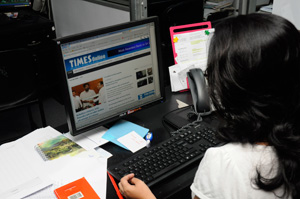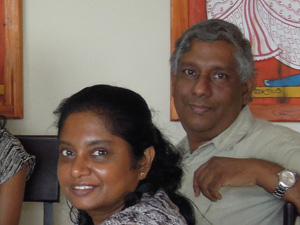From a printed page to an online presence which began 16 years ago, the Sunday Times’ foray into the web is entwined with the advent of the Internet to Sri Lanka.
With the beginnings of the internet in 1983 came electronic mail. At that time academics around the world began using it as a means of communication — seeing it as a convenient and relatively inexpensive way of doing so, but its reach however, remained limited to academia.
In the ’80s those who had access to email would send around any bits of news from Sri Lanka, and this eventually evolved into SLNet — an email network of more than a thousand Lankans around the world. This was initiated by Dr. Gihan Dias (a professor at the University of Moratuwa) and a few like-minded postgraduate students in the United States, Britain and other countries in 1988.
 |
| The Sunday Times online edition: Bringing readers news throughout the week. Pic by Saman Kariyawasam |
At the time CompuServe was the only public access news service and Dr. Kavan Ratnatunga who was among those behind the setting up of our online edition recalls dialing a phone number via a modem to connect to CompuServe to read Sri Lankan news and wire reports, which were downloaded, edited and posted daily to SLNet. News posted on SLNet reached subscribers faster than word would reach the Sri Lankan Embassy abroad from the Foreign Ministry.
The ripples of the net were being experimented with in the ‘90s through a project called LEARN (Lanka Education And Research Network) which was undertaken by the University of Moratuwa. It was during this time that the Lanka Academic Network (LAcNet) was founded by SLNet in 1991 as a non-profit. A significant achievement by LAcNet was to run an email link to Sri Lanka for five years via a daily dial-up connection to LEARN.
Then in 1993, the first internet browser was launched, and the commercial accessibility of the World Wide Web became a reality. But it was only in May 1995 that Sri Lanka was officially connected to the real global Internet through the founding of Lanka Internet Services — the country’s first internet service provider.
When the country hooked up online in ‘95, users were hungry for news, recalls Dr Dias. Against the backdrop of political upheavals in the country, a raging civil war which precipitated one of the deadliest attacks with the bombing of the Central Bank in January 1996, it was an anxious time for expatriate Sri Lankans who were longing for news from home and were looking for alternatives rather than expensive foreign phone calls, and airmail which would take two weeks to arrive.
Sri Lanka had not yet penetrated the radar of consciousness of the western media and even the bloodiest battles would have little or no mention on foreign news websites.
It was to meet this need for news from home, that LAcNet urged the editor of the Sunday Times to set up an online edition, (for which LAcNet willingly sponsored the first two years) and the Sunday Times ventured to showcase its print edition on the web.
 |
| Behind the pioneering partnership of LacNet and ST: Drs. Gihan and Dileeka Dias |
To set up our first print edition, the Sunday Times sought the expertise of Dr Dias, his wife Dileeka (now a professor at the University of Moratuwa), and staff members of Infolabs (a company started by Dr Dias). Our first print edition made its way online in March 1996, following two test editions. It racked up a weekly readership of more than 15,000 views (in an age when the penetration of the net was low and still finding its way into the homes of people). The Sunday Times e-edition as we called it then would become the second online newspaper in Sri Lanka; the Daily News and Sunday Observer went online in September 1995.
Dileeka Dias was involved in all aspects of setting up the site — from the initial meetings, to the design of the templates and software, and the actual uploading of the paper when staff members fell short. She was also the creator of the articles’ archive and the search facility, which allowed one to find an article posted months ago. This was before Google was even thought of.
With a lack of software for website creation each page had its own template designed in HTML. Infolabs wrote software programmes that would convert Word documents into the HTML language. From the beginning, each article had a unique name and could be referred to from other websites.
Dr. Dileeka Dias remembers the many requests in those days by readers for old articles of the Sunday Times and this came as a surprise. Such requests were a constant reminder to our team of the importance of maintaining an archive for old editions online. Each issue of the Sunday Times was posted to a new folder with that edition’s publication date.
At present, we are the only Sri Lankan newspaper to have preserved our archives since its inception online in 1996, and continue to do so.
It was an exciting time for the team at Infolabs — they were dealing with new technology, although now it may seem primitive. Every Saturday night, once the Sunday edition was done, articles would be saved onto a diskette and delivered to the Infolabs office in Ratmalana. Then the Infolabs team would wake up early on Sunday morning, and compile it into the templates that were designed, and upload it to the Sunday Times server, which was located in the U.S.
Among the impediments of the print edition getting on the web in those days, recalls Gihan, was ‘Blackie’. “Blackie was the owner’s dog who would prowl around the garden early morning and would prevent us from entering the office.”
“Sri Lankans all over the world were waiting for the paper to be online, and we found that many people were checking to see if the new edition was there even before we uploaded it,” says Gihan recalling those days. Today it is has become second nature for our Sri Lankan readership overseas that Sunday mornings should begin not with breakfast but our online edition before them. “Even now, people tell us they remember reading the Sunday Times 16 years ago.”
From power failures to power cuts and battery powered mechanisms which were resorted to in the ’90s, our print edition made its passage to our online domain every week for six years in this manner, without faltering. “We knew that there were many people waiting for the paper, and considered it a service to the community, for those who had supported us in our endeavours,” says Gihan.
Then, on April 7, 2002, the Sunday Times in-house team took up the challenge of uploading the print edition and since then has continued to do so under web manager Ramesh Kandasamy. In addition to taking on the sole responsibility of having it online and on time every Sunday, he also had the arduous task of designing templates with notepad in html and uploading the Sunday edition into those templates each week — working into the early hours of Sunday morning — an aspect that after all these years still continues.
Today, 16 years later the need for news has not diminished, but the outlets from which to access it have grown and the means by which we do so have evolved to include mobile phones, tablets and so on.
It was these developments and in keeping with the times, so to speak, that led to the setting up of ‘Times Online’ — a continuously updated news site which is the face of our online edition (www.sundaytimes.lk) at present. Set up July 2008, it offers readers a daily snapshot of the latest happenings. Where previously one had only Sunday’s print edition to access throughout the week, we now offer our readers not only local news but world news, sports, business and feature stories as well 24/7. This is in addition to the videos, photos and an interactive graphics gallery (a first in the country for a local news site). For the social media fiends who look to follow us, they can find us at twitter.com/timesonlinelk and facebook.com/TimesOnlinelk
While we continue to develop our online presence, our emphasis, however, remains the same — to provide our readers with a source from which to access the latest credible news not just through our print edition on Sunday but also through our breaking news reports. And with one of the oldest archives of a newspaper in our possession, its true promise, we believe, will be felt by the generations to come — for whom we would have left, if nothing else, a credible chronicle of a time as we knew it. |



